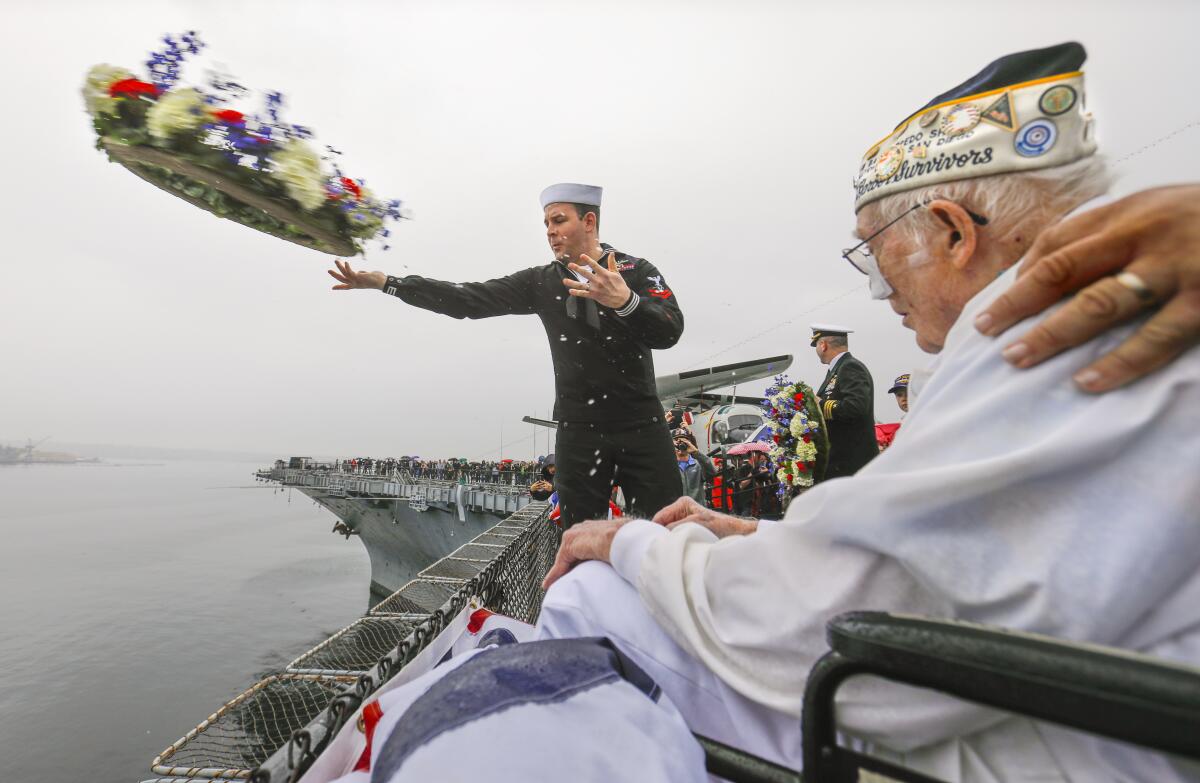Annual Pearl Harbor ceremony touched with sadness as number of survivors dwindles

- Share via
SAN DIEGO — The USS Midway Museum hosted its annual Pearl Harbor ceremony Saturday, and how the story of the attack on the morning of Dec. 7, 1941, gets told is shifting as the number of survivors dwindles.
It used to be that all the attention went to the service members who were on the island of Oahu that morning and suddenly found themselves at war. Surviving that horror — 2,400 dead, 1,200 injured — made them heroes at the Midway commemorations in San Diego, which started 15 years ago. They gave speeches and tossed memorial wreaths off the flight deck.
Ten years ago, there were about 20 survivors at the ceremony. Saturday, there was one: Clayton Schenkelberg. He’s 102, and in a wheelchair. When it came time for the wreath, his son rolled him to the edge of the flight deck, where his great-grandson did the tossing.
The torch of remembrance is being passed.
“It will be sad when everybody’s gone,” said Pat Thompson, a San Diegan who was a 10-year-old girl living with her Navy radioman father at Pearl Harbor when the Japanese planes arrived 78 years ago. She thought they were American and went outside to wave.
Thompson and another “child survivor” were singled out in the audience by Scott McGaugh, the Midway’s marketing director, who emceed the ceremony. Several times during his remarks, he talked about the families of the servicemen and what they endured during and after the attack.
Thousands of spouses and children were evacuated to the mainland, he said, while others stayed in Hawaii amid rumors that another invasion was coming, or that the water supply had been poisoned. There were air-raid practices at school, and black-out curtains at home. Even children were required to carry ID cards, complete with fingerprints.
“Imagine the uncertainty,” McGaugh said. “They all exhibited a quiet heroism in their own way.”
The ceremony drew several hundred people, a smaller crowd than in previous years, probably because of the rain, which grounded a planned airplane fly-over. It sent many of the guests for cover under the wings of aircraft parked on the flight deck and forced the organizers to move up the wreath toss by about 20 minutes; they usually aim it for 9:55 a.m., the minute the Japanese planes first swarmed Pearl Harbor.
But the rain didn’t keep people from rising spontaneously to give Schenkelberg a standing ovation when he was introduced. He attended with his son, Patrick; two grandsons, Shaun and Todd; and his great-grandson, also named Patrick. The grandsons and great-grandson are retired or active-duty military, all Navy, and they were there in uniform. To follow in the footsteps of someone who was at Pearl Harbor, Shaun said, is “very humbling.”
During the attack, Schenkelberg was stationed at a Navy submarine base. Fearing what would happen if Japanese bombs hit a stockpile of torpedoes sitting on a railroad car, he drove the train to a safe spot. Then he dodged enemy bullets while making his way back to the base.
First-hand accounts like that have always animated our understanding of World War II, McGaugh said, and “when that history is gone, the story will change. That presents challenges for us. But the lessons of Pearl Harbor and what came after it will be no less important, no less poignant, and it will be up to the rest of us to find new ways to continue to tell those stories.”
Saturday’s featured speaker was Karl Zingheim, the Midway Museum’s historian, and his talk connected the past to the future, too, reminding the audience of how galvanized and united America became in the aftermath of the Japanese attack: “Everyone pitching in,” he said, “in every conceivable way.”
Wilkens writes for the San Diego Union Tribune
More to Read
Sign up for Essential California
The most important California stories and recommendations in your inbox every morning.
You may occasionally receive promotional content from the Los Angeles Times.










